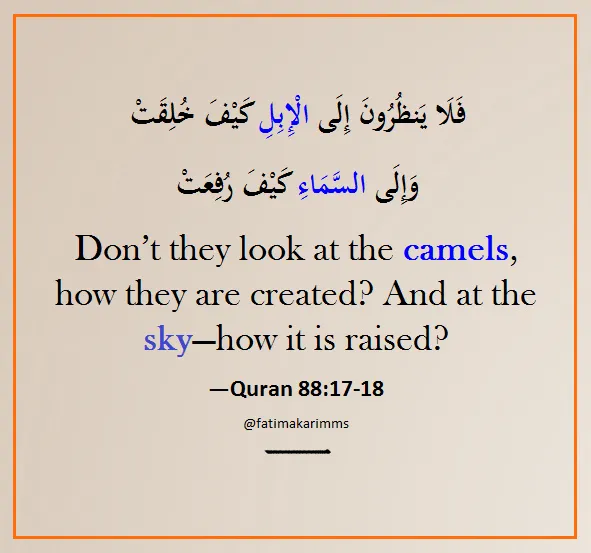أَفَلَا يَنظُرُونَ إِلَى الْإِبِلِ كَيْفَ خُلِقَتْ
وَإِلَى السَّمَاءِ كَيْفَ رُفِعَتْ
Don’t they look at the camels, how they are created?
And at the sky—how it is raised?
-Quran 88:17-18

The camel was the most important animal for the Arabs. It was their means of transport carrying their load and belongings. It nourished them with food and drink. From its hair and skin they made their clothes and tents. Camel is unique among all animals. Despite its strength, size and firm build, it is not wild. Even a young boy can manage it. It gives man great service and, at the same time, it is inexpensive to keep and its food is easy to find. Moreover, it is the only animal to endure hunger, thirst, hard work and poor conditions.
So, the Qur’an, asks of its first audience to ponder on how the camel is made. This does not require them to undertake any difficult task or to discover any obscure field of science. Camels were a part of their world, and they only needed to look and consider how they were made most suitable for their role; how their shape and build fitted perfectly with their environment and function. Man did not create camels, nor did camels create themselves. So, they must have been made by the Supreme Maker whose work reflects His limitless ability and perfect planning, and testifies to His existence.
"anyone who studies the complexities of life and the universe cannot help but witness the signature of the Creator." -Dr. Laurence B. Brown, The Big Questions.
Laurence Brown is an American medical doctor. he converted to Islam. He is My favorite author.
I have read two of his books.
- MisGod’ed >PDF> http://leveltruth.com/?p=1214
- God’ed? >PDF> http://leveltruth.com/?p=1219
I recommend to read the article and watch the lecture on Youtube. Very informative.
https://medium.com/@Marytn/the-big-questions-dr-laurence-b-brown-fb561f06bf72
lecture on Youtube The Big Questions Dr. Laurence B. Brown
